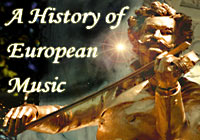The earliest evidence we have of musical instruments dates back to the Old Stone Age. We know that there were rich musical traditions in ancient Mesopotamia, Egypt, India, China and elsewhere. Indirectly, it is possible that some aspects of Babylonian musical theory and practice influenced the Greek, and by extension European, musical tradition. The ancient Greeks used various musical instruments such as harps, horns, lyres, drums and cymbals. Greek music theory evolved continually from Pythagoras before 500 BC to Aristides Quintilianus in the late third century AD, whose treatise
De musica (
On Music) is an important source of knowledge of the Greek musical tradition. Music was closely connected to astronomy in Pythagorean thought, as mathematical laws and proportions were considered to be the underpinnings of both musical intervals and the heavenly bodies.
continue reading
From the desk of Fjordman on Tue, 2009-07-07 18:11 The era from roughly 1600 to about 1750 has in retrospect been called the Baroque period in European history. The creativity among musicians during this age paralleled new ideas in science, politics and economics embodied in the Scientific Revolution. In art and architecture as well as in music, the Baroque began in Italy. Many great works of art had been made in Renaissance Italy, among them the Pietà sculpture in St. Peter’s Basilica and the decoration of the Sistine Chapel by Michelangelo and those created in the Vatican by Raphael.
The theatricality of the Baroque period’s art can be seen in the works of the Italian sculptor and architect Giovanni Lorenzo Bernini (1598-1680), who served no less than eight popes in his lifetime. Bernini’s life-size marble sculpture of the Biblical David (1623) depicts movement in an entirely new way and hence looks more dramatic than Michelangelo’s masterly nude depiction David (1501-4). Bernini’s Ecstasy of St. Teresa (1645-52) in Rome is another of his greatest marble sculptures. His most famous architectural works include the design for the spectacular square in front of St. Peter's Basilica in Rome. Bernini was a deeply believing Roman Catholic who felt that the purpose of Christian art was to inspire the faithful.
continue reading
From the desk of Fjordman on Thu, 2009-07-09 14:51 The Austrian
Joseph Haydn (1732-1809) was the most celebrated composer of his day, prolific in every medium, but best remembered for his numerous symphonies and string quartets, which established standards of form and quality that others emulated. “Haydn has been called ‘the father of the symphony,’ not because he invented the genre but because his symphonies set the pattern for later composers through their high quality, wide dissemination, and lasting appeal.” He was born in a village near the border of Hungary and became a choirboy at St. Stephen’s Cathedral in Vienna at the age of seven, where he acquired practical experience in music and learned signing, harpsichord and violin. He spent most of his career serving the Esterházy family, the most powerful Hungarian noble family. For years he was responsible for composing on demand at a prodigious rate, but this also allowed him the opportunity to experiment and to hear his music performed under excellent conditions.
continue reading



![]()





















